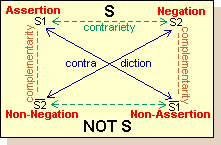'Binarism' has been defined as 'the passion of those who tend to see everything as divided into two categories' (Hervey 1982, 24).
'The world is divided into those who divide people into two types, and those who don't'. The interpretive usefulness of simple dichotomies is often challenged on the basis that life and (perhaps by a misleading 'realist' analogy) texts are 'seamless webs' and thus better described in terms of continua. But it is useful to remind ourselves that any interpretive framework cuts up its material into manageable chunks. The test of its appropriateness can surely only be assessed in terms of whether it advances our understanding of the phenomenon in question.
http://www.aber.ac.uk/media/Documents/S4B/sem05.html
'The world is divided into those who divide people into two types, and those who don't'. The interpretive usefulness of simple dichotomies is often challenged on the basis that life and (perhaps by a misleading 'realist' analogy) texts are 'seamless webs' and thus better described in terms of continua. But it is useful to remind ourselves that any interpretive framework cuts up its material into manageable chunks. The test of its appropriateness can surely only be assessed in terms of whether it advances our understanding of the phenomenon in question.
 The structuralist semiotician Algirdas Greimas introduced the semiotic square (which he adapted from the 'logical square' of scholastic philosophy) as a means of analysing paired concepts more fully (Greimas 1987, xiv, 49). The semiotic square is intended to map the logical conjunctions and disjunctions relating key semantic features in a text. Fredric Jameson notes that 'the entire mechanism... is capable of generating at least ten conceivable positions out of a rudimentary binary opposition' (in Greimas 1987, xiv). Whilst this suggests that the possibilities for signification in a semiotic system are richer than the either/or of binary logic, but that they are nevertheless subject to 'semiotic constraints' - 'deep structures' providing basic axes of signification.
The structuralist semiotician Algirdas Greimas introduced the semiotic square (which he adapted from the 'logical square' of scholastic philosophy) as a means of analysing paired concepts more fully (Greimas 1987, xiv, 49). The semiotic square is intended to map the logical conjunctions and disjunctions relating key semantic features in a text. Fredric Jameson notes that 'the entire mechanism... is capable of generating at least ten conceivable positions out of a rudimentary binary opposition' (in Greimas 1987, xiv). Whilst this suggests that the possibilities for signification in a semiotic system are richer than the either/or of binary logic, but that they are nevertheless subject to 'semiotic constraints' - 'deep structures' providing basic axes of signification. c.f Shaw & Gaines (Comparing Constructions)
Jameson suggests that Not S2, the negation of the negation, 'is always the most critical position and the one that remains open or empty for the longest time, for its identification completes the process and in that sense constitutes the most creative act of the construction' (ibid., xvi).
Critics of structuralist analysis note that binary oppositions need not only to be related to one another and interpreted, but also to be contextualised in terms of the social systems which give rise to texts (Buxton 1990, 12). Those who use this structuralist approach sometimes claim to be analysing the 'latent meaning' in a text: what it is 'really' about. Unfortunately, such approaches typically understate the subjectivity of the interpreter's framework. Illuminating as they may sometimes be, any inexplicit oppositions which are identified are in the mind of the interpreter rather than contained within the text itself (Culler 1975; Adams 1989, 139). Yet another objection is that 'the question of whether categories like sacred/profane and happiness/misery are psychologically real in any meaningful sense is not posed and the internal logic of structuralism would suggest it need not be posed' (Young 1990, 184).
http://www.aber.ac.uk/media/Documents/S4B/sem05.html
No comments:
Post a Comment